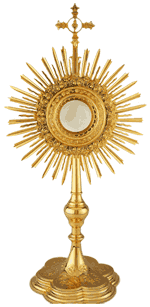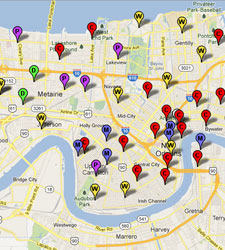The Sacrament of Love: the Holy Eucharist
(part 1 of 3)
On March 13, 2006 the Vatican released an Apostolic Exhortation of His Holiness, Pope Benedict XVI entitled Sacramentum Caritatis – the “Sacrament of Love” – in which the Holy Father offered “some basic directions aimed at a renewed commitment to Eucharistic enthusiasm and fervor in the Church.” The document offers the Holy Father’s reflections on the Synod of Bishops called by Pope John Paul II at the conclusion of the Year of the Eucharist (October 2004 – October 2005).
Sacramentum Caritatis is the second major document of the Pontificate of Pope Benedict and must be read in the context of his first Encyclical, Deus Caritas Est – “God is Love” – itself a meditation on the nature of love. Although the Holy Father uses many expressions to describe the Holy Eucharist in the Exhortation, the title, “Sacrament of Love” – a phrase used by St. Thomas Aquinas – provides a guiding principle to understanding the Blessed Sacrament.
The Exhortation is divided into three parts. The first part, entitled “The Eucharist, A Mystery to be Believed,” explains the teachings of the Church on the Eucharist. The second part, “The Eucharist, A Mystery to be Celebrated,” focuses on the celebration of the Mass and the worship of the Blessed Sacrament outside of Mass. And the third part, The Eucharist, “A Mystery to be Lived,” places the Eucharist into the context of Christian life.
“The Mystery to be Believed” summarizes the Eucharistic faith of the Catholic Church in beautiful language and imagery. Because the Eucharist is “the gift that Jesus Christ makes of himself,” “the Eucharist reveals the loving plan that guides all of salvation history (cf. Eph 1:10; 3:8- 11)” [where] the Triune God who is essentially love (cf. 1 Jn 4:7-8), becomes fully a part of our human condition. In the bread and wine under whose appearances, Christ gives himself to us in the paschal meal (cf. Lk 22:14-20; 1 Cor 11:23-26), God’s whole life encounters us and is sacramentally shared with us.” The Eucharist therefore is the “source and summit” of the Church’s life and mission since in the Holy Eucharist, Jesus, the true Sacrificial Lamb, is offered to His people again at every Holy Mass. The Pope is keen to make the distinction between the ritual meal of Passover in which context the Holy Eucharist was given by Jesus as his gift to the Church, and the anticipation of the sacrifice of the cross and the victory of the resurrection. The Mass is not just a repetition of the Last Supper but a radical reality, indeed the “substantial conversion” of the bread and wine into the Body and Blood of Our Lord. As the Holy Father so eloquently states: “the Church is able to celebrate and adore the mystery of Christ present in the Eucharist precisely because Christ first gave himself to her in the Sacrifice of the Cross.” Christ loved us first, and for all eternity He continues to love us first.
In the first part, the Holy Father also puts the Eucharist into the context of the other sacraments, particularly the other two sacraments of initiation: Baptism and Confirmation. The whole of Christian initiation is in relation to the ecclesial community and the family, but the Eucharist must also be understood in a particular way as a “personal encounter with Jesus.” In this section, the Pope gives a beautiful exposition of the intrinsic relationship between the Holy Eucharist and the sacrament of Reconciliation. He states that in a culture determined to eliminate the concept of sin we are in danger of overlooking the need to be in a state of grace to worthily receive communion. The Holy Father therefore urges the bishops of the world to renew their efforts in the catechesis of the sacrament of Reconciliation in their own diocese, encouraging frequent confession among the faithful. He also urges priests to dedicate themselves with “generosity, commitment and competency” to the administration of the sacrament of Reconciliation.
Each of the seven sacraments is treated by the Pope in this first part. In the subsection on the Eucharist and Holy Orders the Holy Father restates the Church’s teaching that priestly ordination is an “indispensable condition” for a valid celebration of the Eucharist, because the Bishop or the Priest presides in the person of Christ the Head. And since the priest is above all a servant of others and a sign pointing to Christ, he should reflect Christ in “his humility in leading the liturgical assembly, in obedience to the Rite, uniting himself to [the Rite] in mind and heart, and avoiding anything that might give the impression of an inordinate emphasis on his own personality.” In keeping with recent emphases made by the Holy See, the Holy Father also points to the complete configuration of the priest to Christ, especially in his celibacy, which must not be understood simply in functional terms. The Holy Father reaffirms the nuptial understanding of celibacy and reaffirms “the beauty and the importance of a priestly life lived in celibacy as a sign expressing total and exclusive devotion to Christ, to the church and to the Kingdom of God.”
In his discussion of the Eucharist and Matrimony the Pope highlights the particular relationship of the Eucharist with the love of a man and woman united in marriage. “By the power of the Sacrament, the marriage bond is intrinsically linked to the Eucharistic unity of Christ the Bridegroom and his Bride, the Church.” The Holy Father also confirms the Church’s teaching with regard to the reception of Holy Communion by the divorced and remarried, encouraging their participation at Holy Mass, albeit without receiving communion, and their dedication to a life of charity.
[Next week, part 2: “The Eucharist, A Mystery to be Celebrated]




